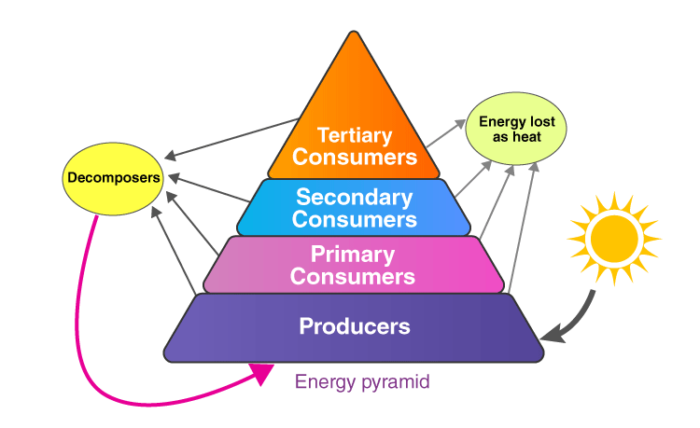Ecosystem
Mode of nutrition in animals and plants
Autotrophic and Heterotrophic
Saprophytes and decomposers
Saprophytes are plants, fungi and microorganisms that feed on the dead and decaying material.
Decomposers break down the organic matter or waste material and release nutrients into the soil. For example, bacteria, worms, slugs, and snails.
Abiotic components
Non living chemical and physical components of the environment like the soil, air, water, temperature, etc.
Biotic components
Living organisms of the environment like the plants, animals, microbes and fungi.
Ecosystem
- Includes both biotic and abiotic components.
- In a given area, all the living things such as plants, animals and organisms interacting with each other, and also with their non-living environments, i.e., weather, earth, sun, soil, climate, atmosphere.
Trophic levels
It refers to the various levels in a food web as per the flow of energy.
The different trophic levels are –
- Producers (T1)
- Primary consumers (herbivores-T2)
- Secondary consumers (primary carnivores -T2)
- Tertiary consumers(Sec carnivores -T3)
- Quaternary consumers (Ter. carnivores T4)
- Decomposers
Pyramid of trophic levels
- Is a graphical representation.
- Can be the pyramid of numbers, pyramid of biomass or pyramid of energy.
- All the pyramids start with producers.
a) Pyramid of numbers: gives the number of organisms present at each trophic level.
It can be upright or inverted.
b) Pyramid of biomass: gives the biomass of each trophic levels and could be upright or inverted.
c) Pyramid of energy: is always upright as it shows the flow of energy from one trophic level to the next trophic level.

Law of conservation of energy
- Energy can neither be created nor destroyed; rather, it transforms from one form to another.
- In biological systems, it gets passed from one organism to another across trophic levels.
Energy flow
- Transfer of energy from one trophic level to another depicting its direction and amount.
- Can be represented by the pyramid of energy.
- In any food chain, only 10% of the energy is transferred from one trophic level to another.
Food chain
A series of organisms each dependent on the next as a source of food.
Food web
- Is formed by interconnections of different food chains.
- Is a graphical representation of ‘Who eats Whom’ in an ecosystem.

Characteristics of ecosystem
- Includes the summary of trophic levels.
- Their energy flow and pyramids.
Environment
- Includes all living and nonliving things.
- Unlike ecosystem, there need not be any necessary interaction between them.
Pollution
Air pollution
Introduction of pollutants, organic molecules, or other hazardous substances into earth’s atmosphere.
Sources:
a) Natural – forest fire, dust storms, and volcanic activity
b) Man-made – power plants, homes, industries, oil refineries, and transportation.
Ozone layer depletion
The ozone layer protects the earth from the sun’s ultraviolet (UV) radiation. CFCs released into the atmosphere react chemically with ozone molecules and are depleting the layer.
Garbage management
- Involves all the activities and actions required to manage waste from its inception to its final disposal.
- Ensures environmental best practices are followed along with proper monitoring and regulation.
Steps involved:
1. Segregation of waste
2. Collection
3. Transport
4. Treatment
5. Processing & Recycling
6. Disposal
Biodegradable waste
- Waste derived from plants or animals.
- Decomposed into the soil by a natural agent such as weather, water, air, heat, micro-organisms, etc.
Biodegradation
Decomposition of garbage or waste material by living organisms or biological processes.
Comments
Post a Comment